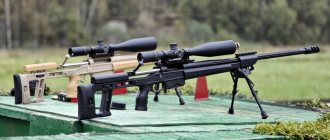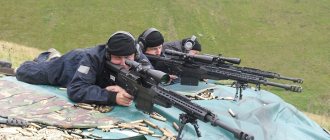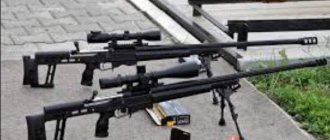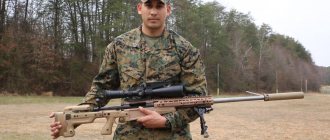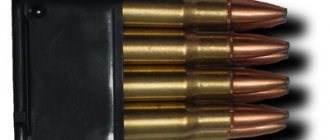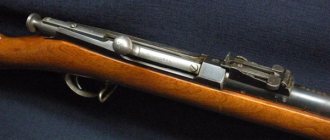This term has other meanings, see M14.
| M14 | |
| M14 | |
| Type | automatic rifle |
| A country | USA |
| Service history | |
| Years of use | 1957 - present |
| Adopted | 1959 |
| In service | see Operators |
| Wars and conflicts | all armed conflicts involving the US Army after the Vietnam War |
| Production history | |
| Designed by | 1957 |
| Manufacturer | Springfield Arsenal |
| Years of production | 1959 — 1964 |
| Total issued | ~1.38 million |
| Options | see options |
| Characteristics | |
| Weight, kg | 3.5 / 5.1 (unammo / loaded) |
| Length, mm | 1120 |
| Barrel length, mm | 559 |
| Cartridge | 7.62x51mm NATO |
| Caliber, mm | 7,62 |
| Work principles | removal of powder gases, rotary bolt |
| Rate of fire, rounds/min | 700-750 |
| Initial bullet speed, m/s | 850 |
| Sighting range, m | 400-500 |
| Type of ammunition | 20-round box magazine fed by M1 clips |
| Aim | adjustable diopter rear sight on the rear of the receiver and front sight in the front sight on the muzzle of the barrel |
| Media files on Wikimedia Commons | |
M14
- American automatic rifle, which was in service with the US Army in the late 1950s-1960s.
Although the M14 has been largely replaced by the M16 family of rifles, it remains in service with the US Marine Corps and Navy as a Marksman rifle, and as the standard rifle in the armies of a number of other countries.
History[edit | edit code]
The experience of military operations in World War II showed that the standard M1 Garand rifle, for all its advantages, needs serious modernization. The greatest criticism was caused by the power supply system of the M1 Garand rifle, which used packs of 8 rounds of ammunition, which did not allow reloading of a half-empty magazine. In addition, a gas engine with a large length and mass of moving parts caused a decrease in firing accuracy.
Experiments to improve the M1 Garand rifle began during the war. In 1944, the Americans created a prototype of the T20
, equipping the M1 with a detachable 20-round magazine from the Browning M1918 automatic rifle, and also introducing the ability to fire in bursts.
After the end of the war, the Americans began work on creating a new cartridge, which, with smaller overall dimensions, would retain the ballistic characteristics of the 7.62x63 mm cartridge. A new cartridge, 7.62x51 mm, was created by the early 1950s, adopted by the US Army in 1952 and standardized as a standard NATO cartridge in 1954.
The next prototype, the T37, was developed for this cartridge, which differed in that the gas chamber was moved slightly back from the muzzle. Further development and testing led to the creation of the T44 prototype, which differed from the T37 mainly in the modified gas engine system, in which the long-stroke design was replaced by a short-stroke design (about 37 mm).
In general, the M14 rifle at the time of its appearance completely satisfied the American military. It was quite light, had a large effective firing range, good accuracy and lethality of the ammunition.
Production[edit | edit code]
The production of rifles was established at the enterprises of the following contractor corporations:[1]
| Production figures[1] | |
| Springfield Armory | &&&&&&&&&0167100.&&&&&0167 100 |
| H&R | &&&&&&&&&0537582.&&&&&0537 582 |
| Winchester | &&&&&&&&&0356601.&&&&&0356 601 |
| TRW | &&&&&&&&&0319163.&&&&&0319 163 |
| Total | &&&&&&&&01380346.&&&&&01 380 346 |
- Springfield Arms Factory, Springfield, Massachusetts (official Army plant);
- Olin-Mathieson Chemical Corp., Winchester Western Division, East Alton, IL (cartridges); New Haven, Connecticut (rifles priced at $116 each)
- Harrington & Richardson Corp.[en], Worcester, Massachusetts (about $150 each).
In 1961, on the initiative of the head of procurement on the part of the customer, the former head of the US Army Armament Directorate, Major General Elmer Gibson, a competition was held for alternative sources of procurement, in which 32 commercial entities were invited to participate, of which 11 submitted applications. In October of the same year, the winner of the competition was announced:[2]
- TRW, Inc., Electromechanical Division, Cleveland, Ohio (at $79.49 each);
TRW's Cleveland electromechanical plant was hastily converted from rocket parts production to rifle production. The first rifles arrived from the TRW factory in October 1962, a month ahead of the delivery schedule, TRW quickly increased production rates and by the summer of 1963 the average monthly production reached 24 thousand rifles per month (288 thousand per year) with a much lower product price that of competitors (31.5% cheaper than Winchester products and almost two times cheaper than H&R). The production of barrels was organized using German technology of cold stamping of the barrel bore and rifling fields[3]. The production line for the M14 rifle was prepared at the Maremont Corp. automobile silencer plant. in Saco, Maine, but Maremont did not receive the contract and the line had to be repurposed to produce M60 machine guns.
Related products[edit | edit code]
Together with the M-14, the following were developed and adopted by the US Army:
- device for loading magazines ( M14 Magazine Loader
) - M76
rifle grenade launcher (which was mounted on a rifle), as well as a cumulative 66-mm M31 rifle grenade[4]. - night sights - several lightweight night sights of various magnification, diameter and thickness of the objective lens have been developed, operating in passive mode to enhance the reflected light of celestial objects (the moon and starry sky), [5] in addition to the already existing active thermal imaging (infrared) sights .[6]
Operation[edit | edit code]
A 1968 photograph shows that even after the adoption of the M16 rifle, some units continued to use the M14.
However, the M14 proved to be of little use in the new conditions of war, as US combat operations in Vietnam quickly revealed. The M14 was too long for battles in the jungle, the large mass of each cartridge reduced the carryable ammunition to unacceptably small, firing bursts from a rifle with any precision was possible only from a bipod or rest, and even then at short ranges. Most rifles were issued to soldiers with the fire mode translator removed, since in most cases, firing in bursts was nothing more than a waste of ammunition - according to reviews of those who fired from the M14, at a distance of 100 meters, the 3rd bullet in the burst went 10 meters above the initial aiming point . If necessary, the translator could be installed back on the rifle in the field.
Removal from service[edit | edit code]
As a result, the US Army had to urgently adopt a new model - Armalite AR-15/M16 chambered for a small-caliber intermediate cartridge of 5.56x45 mm. In 1963, the intention was announced to replace the M14 in the US armed forces with 5.56 mm machine guns[7]. However, the M14 was the main rifle in the Marine Corps until 1967, and thereafter remained in service with the US Navy and National Guard.
Removal from storage[edit | edit code]
In mid-2003, the US government decided to sell 300 thousand M-14s from army warehouses[8]
There was a scandal
In 2012, when the transferred M14s were pretty worn out, and the Lithuanian army acquired more recent models (let me remind you that now the main rifle in Lithuania is the German G-36), the American inheritance was transferred to the so-called Weapons Fund. And here a little trouble happened: the Foundation (a structure that is part of the country’s Ministry of Defense) decided to sell the rifles that had become unnecessary to those who wanted them at a oh-so-tasty price - only 347 and a penny euros per piece. Eight Lithuanian citizens managed to snatch a rare firearm (you must understand that the market value of the M14 is five times higher, and for early modifications prices can reach 25,000 euros).
It would seem that you’ve got it, just sit quietly and enjoy life. But these are collectors - they definitely need to show off. The information appeared on forums, and from there it reached the ears of US intelligence agencies. The Americans were outraged: according to the 2002 agreement, weapons transferred to Lithuania could not be sold to third parties, especially to any civilians. And it’s not about the ancient pieces of iron released almost half a century ago, it’s about the principle! Lithuanian government agencies began to sadly deny: they say, the agreement is 2002, and the weapons were transferred in 1999, so the agreements should not apply to them. But the Americans are a stubborn people and they ate the dog in court cases. The latest news on this matter came a year and a half ago: local courts declared the deal to sell M14 to private individuals illegal, but no one is going to buy them back at market value.
Design[edit | edit code]
The M14 rifle is a magazine-fed automatic weapon with an automatic gas engine. The gas outlet unit is fixed under the barrel, the gas piston is made in the form of a glass and has a short stroke. In this case, gases are supplied into the gas piston through a hole in the barrel and a hole in the piston wall, and after the piston moves back a few millimeters, the supply of gases into the piston is automatically shut off, thereby cutting off “extra” gases and softening the operation of the automation. The gas piston does not have its own return spring. It acts on the bolt frame located under the barrel, which is connected to the rotary bolt by a long lever. The design of the bolt is similar to that of the M1 Garand; it locks the barrel by turning to the right onto 2 lugs that fit into the cutouts of the receiver. The usual bolt lug that interacts with the bolt carrier is replaced in the M14 with a roller to reduce wear. The return spring is located under the barrel and acts on the bolt frame. The trigger mechanism is a trigger mechanism, similar to the M1 Garand, but with the addition of a mechanism that allows burst firing. and a fire mode translator on the right side of the receiver, above the trigger. On the left side of the receiver there is a bolt stop that stops the bolt in the open position after all the cartridges in the magazine have been used up. The magazines are box-shaped, detachable, double-row, 20 rounds. The magazines can be loaded without disconnecting from the weapon using standard 5-round clips, for which guides for the clips are made on the top of the receiver. The safety lever is located in the front part of the trigger guard. Sights - an adjustable diopter rear sight on the rear of the receiver and a front sight in the front sight on the muzzle of the barrel.
The barrel is equipped with a slotted flash suppressor and has a bayonet mount
The barrel is equipped with a slotted flash suppressor and has a bayonet mount. The stock is wooden, with a semi-pistol grip and a metal top plate on the barrel. The M14A1 rifles have a stock of a different design - wooden with a pistol grip and a butt raised to the line of the barrel. The M14A1 forearm has a folding front handle, a light bipod is attached to the gas chamber, and a special removable muzzle brake-compensator is attached to the flash suppressor.
Options and modifications[edit | edit code]
Springfield Armory M1A (self-loading variant of M14) Rifle with night sight[6]
- M14A1
- modification of 1963. It was intended to use the M14 as a light machine gun to replace the outdated BAR M1918A2 rifle (7.62x63 mm). To do this, a pistol grip was added to the butt, the rifle was equipped with a bipod, a folding front handle and a removable muzzle brake-compensator. - M14M (M14, Modified)
- commercial version, self-loading rifle with the ability to fire only single shots - M14 National Match
- commercial version, “target” rifle with improved processing of the bore and trigger mechanism parts - The M1A
is a commercial self-loading variant manufactured by Springfield Armory, with a standard wooden stock, stock and receiver, which began production in late 1971; equipped with magazines for 5, 10 or 20 rounds[9].
- M1A-A1 Scout
- modification of the M1A, a commercial self-loading version manufactured by Springfield Armory, with a standard wooden stock and stock; a new receiver lining made of black plastic and fiberglass; a mount for an optical sight, a new flash hider and an adjustable bipod[10]. - The M1A-A1 Bush
is a modification of the M1A, a commercial self-loading variant manufactured by Springfield Armory, with a new stock, stock and receiver made of black plastic and fiberglass.[11] - M1A SOCOM 16
- 2004 model with a barrel shortened to 16 inches and a modified gas exhaust system; - M1A SOCOM II
- 2005 model, modification of M1A SOCOM 16 with Picatinny rail
- The M14A
and
M14SA
are commercial self-loading variants manufactured in 1984–1991 by the Federal Ordnance from standard automatic M-14s. - The M21
is a sniper rifle developed in the 1960s based on the M14 National Match "target" rifle. - M25 Sniper Weapon System
is a sniper rifle developed in the early 1990s for special forces of the US Army and Navy - United States Marine Corps Designated Marksman Rifle
- 2001 sniper rifle for the US Marine Corps with a new stock and stock "
McMillan Tactical M2A
", equipped with a Picatinny rail and a "
Harris SL bipod
" - The Mk 14 Mod 0 Enhanced Battle Rifle
is a 2004 sniper rifle for the US Navy Special Forces, with a new stock manufactured by Smith Enterprise Inc., a new barrel, a telescopic adjustable stock, a pistol grip, a bipod, a Picatinny rail and a modified flash hider.
- MK14 Mod 0 type SEI
- commercial self-loading version of the Mk 14 Mod 0 manufactured by Smith Enterprise Inc. - LDT M14
is a commercial upgrade similar to the Mk 14 Mod 0 EBR manufactured by LuxDefTech SA (wooden fittings are replaced with a new plastic handguard, pistol grip and telescopic stock)[12]
- SOCOM II M1A
and
SOCOM 16
- modernized versions of 2005 from lighter production materials with a barrel shortened to 412.7 mm, a new compensator brake, a Cluster rail handguard (with Weaver-type straps) and a 10-round magazine [13 ]. - M39 Enhanced Marksman Rifle
- 2008 Marksman rifle for the US Marine Corps with a new stock and stock, equipped with a Picatinny rail, an M8541 Scout Sniper Day Scope and a
Harris SL bipod
. - Norinco M305 (Norinco M14S)
- commercial self-loading version made in China - Täpsuspüss M14-TP
is a sniper rifle for the Estonian army, equipped with a heavy barrel, bipod, plastic butt and optical sight of variable (2.5x-10x) magnification. The weight of the rifle increased to 5.8 kg[14].
And finally...
As for the news about fresh deliveries of M14 to Lithuanians, in fact, everything is somewhat different. The official Twitter account of the Lithuanian Armed Forces, indeed, reported that 400 modernized rifles were transferred to the troops.
But we are not talking about a new party from the USA. The weapons were simply taken from warehouses and given new bipods, mounts and sights, and the funds for this were taken from civilian donations. The M14s improved in this way will be transferred to the Marxmen in the Aukštaitija brigade, staffed by reservists.
In general, the topic of modern and vintage weapons in the former Soviet republics is an extremely interesting thing. If you are interested, write in the comments. We will answer what we know, or even make a separate large article. Curious?
Operating countries[edit | edit code]
M39 Enhanced Marksman Rifle in the hands of a US Marine Niger Army soldiers with M14 rifles (1991)
- USA:
- Military: After switching to the M16, it became used as a military sniper rifle.
- Police: as of 2011, in service with local police[15].
- Argentina: Used during the Falklands War[16].
- Afghanistan - a batch of M14s was supplied under the military assistance program from the United States in the period after 2002, in 2020 they were used in the honor guard unit[17]
- Venezuela
- Haiti: Used during the 2004 coup d'état[16].
- Israel: the M-14 was in service with army units until at least 1990[18]; In addition, in the 1980s, based on the M-14, the Sardius M36 Sniper Weapon System
, which entered service under the name TEI M89-SR[16]. - Republic of Korea: during the Cold War, it was supplied under a military assistance program from the United States[19]. Used by reservists and ceremonial units[20].
- Republic of China: during the Cold War, supplied under a military aid program from the United States, produced under license under the designation Type 57[16].
- Costa Rica: In the 1980s, 976[21] M-14s were received from Venezuela[22].
- Latvia: in 1997, the first 10 thousand M14[23] were received from the United States under the military assistance program; a total of 30,500 units were delivered by the end of 2000. M14[24], which were adopted by the army[25].
- Lithuania: in 1999, 40 thousand M14s were received from the United States under the military assistance program; at the beginning of 2001, a number of rifles that entered service with the Prince Vytautas the Great Jaeger Battalion were upgraded to the M14L1
[26]. It is in service with the Lithuanian army[27]. - Niger: in service with the army.
- Poland: in service with the Polish Special Forces, namely the naval special forces "Formoza".
- El Salvador: A number remained in service in 2012[28].
- Estonia: in 1998, 40.5 thousand M14 were received from the USA to create a mobilization reserve[29]. Subsequently, a modernized version of the Täpsuspüss M14-TP
[30].
How did it all start?
Since the young Baltic democracies, from the moment they gained independence, took a course towards de-Sovietization in every sense - this concerned, among other things, small arms of the army and police.
A number of American experts back in the late 1990s expressed restrained surprise at this approach: they say, if the terrible Russian bear decides to lay its paw on recently lost property, the small armies of Lithuania, Latvia and Estonia will still not be able to oppose anything to the shaggy Cossack hordes. The main task of the armed forces in such conditions will be guerrilla actions against the aggressor, and the partisans must feed from the invader. It would be much more logical to preserve the weapons with which a potential enemy is armed - you can always get hold of cartridges. But the desire to get rid of the disgusting Soviet legacy as quickly as possible was stronger: millions of Kalashnikovs, Dragunovs and Makarovs were either sent to warehouses, smelting furnaces, or were sold abroad. In return, at the end of the century, Lithuania received a fair amount of German and Swedish G3/Ak4 rifles chambered for 7.62×51 mm NATO (Germany in those years was switching to the new G36, the surplus had to go somewhere, and the Swedes started modernizing the weapons they had on hand ). The United States also did their best for the new partners: after the destruction of the SVD, the Baltic army was left without sniper weapons, so in 1999 the first batch of M14s was delivered in the amount of as many as 40 thousand pieces. If you want, arm the entire army; if you want, distribute it to the Marxmen.
Grigory Pastushkov Field expert in the reserve
Marksman, also known as a “selected marksman” in the old way, or, simply put, an infantry sniper, differs from an ordinary sniper in that he is part of a unit, and is not a separate tactical unit. Its pipe is lower, the smoke is thinner, but at the same time the tasks are not so difficult - they don’t ask to hit a fly in the eye from a kilometer away. The rifles with which Marksmen are armed, accordingly, are not as accurate as sniper rifles, but they are faster-firing, more reliable and, as a rule, noticeably cheaper.
Notes[edit | edit code]
- ↑ 12
Rayle. Random Shots, 2006, p. 116. - Rayle. Random Shots, 2006, pp. 115-116.
- Rayle. Random Shots, 2006, p. 117.
- N. R. Andreev, N. I. Grishin. US Army Infantry Battalion. M., Voenizdat, 1964. p.39
- Jerome, Harold E.
New Weapons for... Hot Little Wars.
// Popular Mechanics
. - February 1965. - Vol. 123 - No. 2 - P. 146 - ISSN 0032-4558. - ↑ 1 2
Night Sight For 'M14'.
// Military Review
. - July 1963. - Vol. 43 - No. 7 - P. 98. - The M14 service rifle is getting the boot // “Guns & Ammo”, 1963
- USA // “Master Gun” magazine, No. 7 (76), June 2003. p. 24
- The ultimate - the M1A // “Soldier of Fortune”, summer 1975. page 13
- A.E. Hartink. Army weapons: a modern illustrated encyclopedia. M., “Labyrinth Press”, 2005. p. 277
- A.E. Hartink. Army weapons: a modern illustrated encyclopedia. M., “Labyrinth Press”, 2005. p. 276
- LDT M14 / official website of Luxembourg Defense Technologie SA
- Springfield Armory continues to improve the M-14 assault rifle // Master Gun magazine, No. 6 (99), June 2005. p. 6
- Täpsuspüss M14-TP Archived October 22, 2013. / official website of the Estonian Ministry of Defense
- Brad Lockwood.
The Militarizing of Local Police.
The Little Black Book of Billionaire Secrets (English). Forbes
(November 30, 2011). — During Bill Clinton's presidency, 1.2 million weapons and military equipment were transferred to police, including 185 M-14 automatic rifles. — "Bill Clinton doesn't get off clean, either, with 1.2 million military items given to law enforcement under his administration, including 3,800 M-16s, 185 M-14s, 73 grenade launchers and 112 armored personnel carriers." Retrieved April 15, 2020. - ↑ 1 2 3 4 Lee Emerson.
M14 Rifle History and Development (English) (13 January 2006). Retrieved April 15, 2020. Archived March 6, 2006. - POTD: Mattis & the Afghan M14s
- E. Sokolov.
Israeli Ground Forces // “Foreign Military Review”: magazine. - 1990. - No. 4. - P. 21-27. - M.R.
Popenker. Rifle M14 / Mk.14 Mod.0 (USA)
(unspecified)
.
World Guns
. Retrieved April 15, 2020. Archived February 17, 2012. - 자유사진자료실. Retrieved on September 24, 2008.
- Dial Torgenson. Arms for everywhere. Central America caught in race to escalate power // The Milwaukee Journal, January 23, 1983. page 2
- Martha Honey. Hostile Acts: US Policy in Costa Rica in the 1980s. University Press of Florida, 1994. page 299
- Major Richard J. Anderson. US Security Assistance For Estonia. page 8
- Small Arms Survey, Yearbook 2002. page 147
- “ When discussing the topic of small arms, the Latvian military immediately recalls the existence of the Law “On State Secrets”.
As the head of the logistics working group of the Ministry of Defense of Latvia, Colonel-Lieutenant Zemessardze Imants Cirulis, said... some of its types at the disposal of the Latvian army are American automatic rifles M-16 and M-14 , assault rifles and Kalashnikov machine guns
"Latvia actively trades in weapons // DELFI.LV dated October 5, 2001 - Vladimir Vodo. The Lithuanian army adopted rifles from someone else’s shoulders // Kommersant, No. 41 (2171) dated March 7, 2001
- Automatinis šautuvas M-14 // website of the Lithuanian Ministry of Defense
- Julio A. Montes. El Salvador: Standing tall // “Small Arms Defense Journal” vol.3 No.4 dated January 12, 2012
- S. Smirnov. With the world on a thread. The US Department of Defense will donate 40,500 M14 assault rifles to the Estonian Defense Forces, the US Embassy in Estonia announced. // “Merchant Newspaper” dated August 6, 1998
- World Infantry Weapons: Estonia.
Why is the M14 needed now?
Of course, the M14 received by Lithuania at the end of the last century was immediately considered as a kind of palliative - until money was found for more modern models. Funds were found in December 2013, when the Baltic states signed a contract with the FN concern for the supply of very decent modern SCAR-H PR rifles. In 2015, the Belgian wunderwaffe was officially adopted into service.
The best shooter - SCAR-H PR, the machine gunner - MAG, the rest - G3
But either there weren’t enough fashionable SCARs for everyone (they bought only a thousand pieces), or traditional farm kindness made itself felt - who knows; be that as it may, the Lithuanians are not going to give up the M14. The weapons in the army are well-known, familiar, and fully meet modern needs; again, the M14 is good with accuracy, it is quite capable of competing with the domestic SVD. And one more factor: the Emka is a much cheaper weapon: for each SCAR you have to shell out three thousand dollars, and the military department gets M14s in decent condition “without payment, that is, for nothing.” Would you refuse? I definitely don't.
